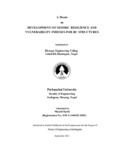Please use this identifier to cite or link to this item:
https://elibrary.khec.edu.np:8080/handle/123456789/700Full metadata record
| DC Field | Value | Language |
|---|---|---|
| dc.contributor.advisor | Dr. Satish Paudel | - |
| dc.contributor.advisor | Dr. Manjip Shakya | - |
| dc.contributor.author | Karki, Manzil | - |
| dc.date.accessioned | 2024-06-06T07:41:35Z | - |
| dc.date.available | 2024-06-06T07:41:35Z | - |
| dc.date.issued | 2023-09 | - |
| dc.identifier.uri | https://elibrary.khec.edu.np:8080/handle/123456789/700 | - |
| dc.description.abstract | Due to the crucial role in urban infrastructure, reinforced concrete (RC) structures have been the focus of much study on their seismic resistance and vulnerability in recent years. Precise indices must be created to evaluate the behaviour of RC structures under seismic loads for effective risk management and decision-making. The proposed seismic resilience index assesses the RC structure's capacity to withstand seismic loads and quickly and effectively recover to its pre-earthquake state. It takes into account things like the losses, functionality and so on. The seismic vulnerability index, on the other hand, assesses the risk of RC structures being damaged or losing their functionality as a result of seismic loads. It considers structural capability, failure mechanisms, and so on. In this thesis, 18 models with different irregularities have been developed using the NNBC code. Both a nonlinear static pushover analysis and a nonlinear dynamic time history analysis were performed on each of these models to determine the seismic vulnerability and resilience indices. The results of the analysis are tabulated. Among the considered building typologies, the result shows that the soft-storey building typologies are most vulnerable for both 4.5 and 5.5-storey buildings with SVI as 0.778 and 0.739 respectively. Similarly, regular building typology considered in this study was shown to be least vulnerable with SVI as 0.342 and 0.426 for 4.5 and 5.5 storeys respectively. The SRI for 5% probability of exceedance for a 4.5-storey regular building was found to be 84.46 % making 4.5-storey buildings the most resilient. | - |
| dc.format.extent | 46 pages | - |
| dc.language.iso | English | - |
| dc.subject | Vulnerability Index|Resilience Index|Pushover Analysis|Fragility curve|Vulnerability Curve | - |
| dc.title | DEVELOPMENT OF SEISMIC RESILIENCE AND VULNERABILITY INDEXES FOR RC STRUCTURES | - |
| dc.type | Thesis | - |
| local.college.name | Khwopa Engineeering College | - |
| local.degree.department | P. G Department of Earthquake Engineering | - |
| local.degree.name | ME Earthquake | - |
| local.degree.level | Masters | - |
| local.item.accessionnumber | D.1376 | - |
| local.item.reportnumber | (Registration No.: 035-3-3-06452-2020) | - |
| Appears in Collections: | Master of Science (M.Sc) in Earthquake engineering | |
Files in This Item:
| File | Description | Size | Format | |
|---|---|---|---|---|
| 020_Manzil Karki.pdf Restricted Access | 5.65 MB | Adobe PDF |  View/Open Request a copy |
Items in DSpace are protected by copyright, with all rights reserved, unless otherwise indicated.
